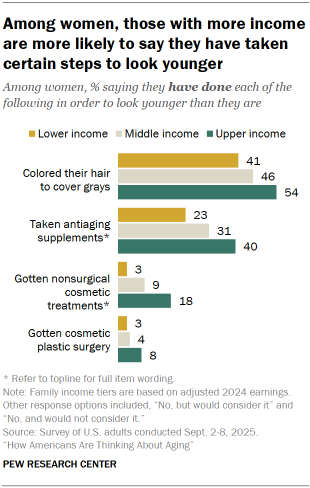As part of a survey aimed at understanding how Americans are thinking about and experiencing aging, we asked people if they have ever done or would consider doing each of the following to look younger than they are:
- Taking antiaging supplements, such as collagen or antioxidants
- Coloring their hair to cover grays
- Getting nonsurgical cosmetic treatments, such as Botox, dermal fillers or laser therapies
- Getting cosmetic plastic surgery
Key takeaways:
- Hair coloring and taking antiaging supplements are the steps Americans are most likely to have taken or to consider taking. Still, some say they either have gotten or would consider getting nonsurgical treatments (23%) or cosmetic plastic surgery (18%) to look younger.
- Women are more likely than men to say they have done or would consider doing these things to look younger. For example, women are more than five times as likely as men to say they have colored their hair to cover grays, and they are four times as likely to say they have gotten nonsurgical treatments or cosmetic plastic surgery.
- Given the cost associated with some antiaging treatments, it’s perhaps not surprising that women in the upper income tier are more likely than women in the middle or lower income tiers to say they have taken any of these measures to look younger.
It’s important to note that we asked specifically if people have done or would consider taking these steps in order to look younger than they are. It is not meant to account for everyone who has done or would consider doing these things.
The survey of 8,750 U.S. adults was conducted Sept. 2-8, 2025. Read key findings from the full study.
What steps have Americans taken to look younger?
Of the four things we asked about, coloring hair to cover grays is the most common step Americans have taken to look younger than they are (27% say they’ve done this). About one-in-five (21%) say they have taken antiaging supplements.

Far smaller shares say they have gotten nonsurgical cosmetic treatments (5%) or cosmetic plastic surgery (3%).
In total, 40% of U.S. adults say they have done at least one of these to look younger than they are.
Some people who haven’t done these things say they would at least consider doing them. Taken together:
- 56% have taken or would consider taking antiaging supplements.
- 52% have colored or would consider coloring their hair to cover grays.
- 23% have gotten or would consider getting nonsurgical cosmetic treatments.
- 18% have gotten or would consider getting cosmetic plastic surgery.
Differences by gender

Women are far more likely than men to say they have taken or would consider taking these steps to look younger.
For example, 45% of women say they have colored their hair to cover grays and 28% say they have taken antiaging supplements. Among men, 8% and 13% have done these things, respectively.
Relatively small shares of men and women say they have gotten nonsurgical cosmetic treatments or cosmetic plastic surgery to look younger. Still, women are four times as likely as men to say they have done these things.
Women are also more likely than men to say they would consider taking these steps. For example, 25% of women say they haven’t had nonsurgical cosmetic treatments but would consider them, and 22% say the same about cosmetic plastic surgery. About one-in-ten men say they haven’t had these procedures but would consider them.
Differences by income, race and ethnicity among women
While women are more likely than men to have taken steps to look younger than they are, there are differences among demographic subgroups of women.
Differences by income

Many women across income groups say they have colored their hair to cover grays. But this is more common among those with upper incomes (54%) than among those with middle (46%) or lower (41%) incomes.
About a quarter of women with lower incomes say they have taken antiaging supplements, a share that rises to 40% among women with upper incomes.
Nonsurgical cosmetic treatments and cosmetic plastic surgery are less common across income groups. Still, about one-in-five women with upper incomes say they have gotten nonsurgical treatments and about one-in-ten say they have had cosmetic plastic surgery to look younger. These shares are much lower among women with middle and lower incomes.
Differences by race and ethnicity
Black women are less likely than White, Hispanic and Asian women to say they have:
- Colored their hair to cover grays: 35% of Black women, 47% of White women, 47% of Hispanic women and 45% of Asian women have done this.
- Taken antiaging supplements: 19% of Black women, 29% of White women, 32% of Hispanic women and 33% of Asian women have done this.
Small shares across racial and ethnic groups say they have had nonsurgical cosmetic treatments or cosmetic plastic surgery to look younger. But while 41% of Hispanic women and about a third of White women (32%) and Asian women (35%) say they have gotten nonsurgical treatments or would consider it, that share drops to 23% among Black women.
Hispanic women (31%) are more likely than White women (25%), Black women (22%) and Asian women (21%) to say they have gotten cosmetic plastic surgery or would consider it to look younger than they are.




